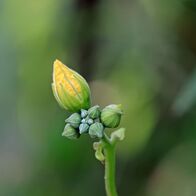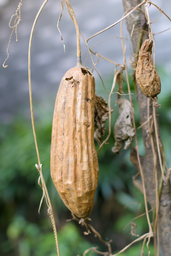 "I thought they were sea creatures!” This is, hilariously, the most common response I get when people find out I grow luffas. And while growing a crop of sea sponges sounds like fun, it doesn’t seem like an endeavor that would see much success here in Pennsylvania (though luffas aren't an easy keeper either). So what actually are luffas, then? Luffas (sometimes spelled “loofa” or “luffah” or even “loofah” – just to complicate your Google searches) are actually gourds. As seedlings they look just like their cucubirt cousins and begin to look a bit like zucchinis as they mature. They grow on vines and if left to dry at the end of the season, will produce a sponge-like skeleton beneath its thin skin. In other parts of the world, they are grown as food and eaten while still green. In North America, most of us are familiar with the dried out versions of luffas you see in gift baskets of fancy bath products.  So how do you grow your own luffas? Or maybe better yet, should you? The first thing to consider is that luffas love hot weather. Not just warm, but hot. I don't know what experts would tell you for their exact zone hardiness, but here in 6b, I know it's really tough to get them fruitfully through the growing season. They need a long season to fully dry out. So of course, start them early. As early as you can is best, but keep in mind they are climbers so you probably want to put them outside before they get too large. Even started early, in my experience they still won’t flower until they are good and ready (i.e., when it’s hot), so the return on starting SUPER early is limited. Once they're hardened off and ready to go outside, plant them near a sturdy trellis. And I do mean sturdy. Green luffas are heavy, and a weak trellis will collapse under their weight (just ask my former garden fence). Like a lot of cucurbits, luffa plants produce both male and female flowers. Male flowers typically come first, so don’t get discouraged if you see flowers falling off without forming fruits! Be patient, soon you'll small green protrusions on these flowers, similar to the way cucumbers appear.  Ideally, your fruits will grow to size and dry out before cold weather sets in. The luffas will turn from green to yellow to brown drying out on the vine, losing moisture and weight over time. You’ll be able to tell when they’re ready to harvest – the skin will turn a papery brown, and be very light weight. You may even be able to hear seeds shaking around on the inside. Of course, if you live in a cooler climate like me, you may not be so lucky as to successfully harvest every single luffa. The warm season simply isn’t long enough for most of them to dry out naturally outdoors. They can withstand cool weather, but a freeze – even a light frost – will cause them to turn black and rot. In my experience, there is no saving them from this point.  Harvest any remaining luffas before your area experiences freezing temperatures. Leave them to dry in a spot that is above freezing, dry, and hopefully bright. Airflow can't hurt. They key is to keep them from freezing and discourage mold. I’ve experimented with spraying and wiping the skins down occasionally with a bleach or tea tree oil solution as a surface preventative. The luffa-drying area should be outside of any living spaces where air quality might be a concern, as there may be an inherent risk of mold with gourd drying even with regular prevention (according at least to one person in a gourd group on Facebook - a generic gourd groups, alas there are no luffa groups). (Side note – I seem to recall reading that they can be dried out in the oven. I think I tried this once and never again because it took way longer than expected and made the house smell funky all day.) So now you've gone through all the painstaking steps of luffa stewardship - from early seed starting and seedling care to planting out, trellising, caring to fruition and finally drying... Now what? Ready for Part II? Click here!
2 Comments
Christine
1/25/2021 09:19:46 am
Great info! This will be my first year growing them here in Kansas(zone 6). Im trying to decide if I should start them mid February or March. What do you think?
Reply
Erin
1/26/2021 03:04:35 pm
Hi Christine!
Reply
Leave a Reply. |
AuthorErin runs the blog for Thirsty Boot Farms. Archives
March 2022
Categories |
 RSS Feed
RSS Feed
